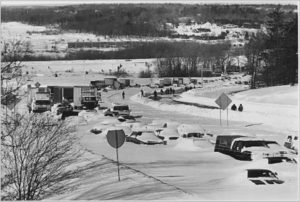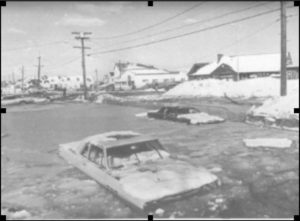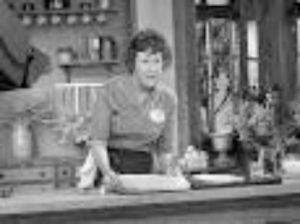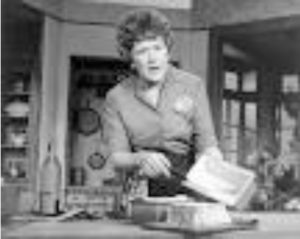Two weeks after I became an intern in the newsroom in Boston’s WBZ-TV, the Monday morning Blizzard of ’78 changed my life.
With only forty hours of training, I was suddenly forced to become part of the production crew keeping our coverage of the blizzard on the air 24/7.
Now, you might consider that would be an amazing opportunity for a college senior about to embark on a career in broadcast journalism. I’m sure it was for the three other interns trapped for a week with me. But, I was a thirty-four year old suburban housewife with three children trapped in their house twenty miles west of Boston, fortunately with their father who managed to arrive home before the roads became impassable.
He was one of the lucky ones who left their jobs early to try to beat the devastation. However, more than 3500 cars and trucks were stranded as trailers jackknifed and blocked drivers along the snowdrifted Route 128. People tried to huddle inside their vehicles as they watched the snow fall at over an inch per hour.

While the calls from the surrounding cities and towns requesting help in finding their loved ones continued to dwindle throughout the week, we scrambled day and night to keep viewers informed of the latest shelters and people found alive in their cars on Route 495.
When the Executive Producer of News asked me to go get the network feed, I thought she was talking about calling a caterer. I soon realized that the NBC network sent a video feed to each affiliate station regularly with national video the stations might want to use in their newscasts. I knew then it would be a long and uphill climb before I would feel comfortable in that environment.
Each night when we managed to make our way through waist-high snow piles stretching from the front door of the station to the Ramada Inn across the street, we wondered how many more days we would need to wear the same outfit we arrived in on Monday morning. My wool slacks rubbed my inner thighs until the burn interrupted every thought. Washing underwear each night in the sink and drying them with the hotel hair dryer became a challenge. The food we ate on night five was merely leftover scraps from the steaks we enjoyed on the first night of what we thought would be an exciting 48 hour adventure. There were no deliveries to the hotel because all the roads were closed and the Governor declared a state of emergency allowing only emergency vehicles on the roads.
The snowmobiles that took our camera crews throughout the city, credited us with the first LIVE shot from the State House with the governor’s message. While he became know for his appearances in his cardigan sweater, we began offering to exchange our outfits with one another just for sport.
The coastal towns flooded as the sea walls gave way to the weight of between two and four feet of snow that fell from Monday morning through Tuesday evening. It became known as the storm of the century. With flood tides cresting at over 15 feet, waves surged over, across and through seawalls.

By Wednesday afternoon, I became very familiar with the routine necessary to choose the most important stories, send a camera crew on snowmobiles and have the edit completed in time for the next news update. By then, we were on live around the clock with updates nearly every hour. The newsroom and control rooms were smelling very gamey. The blizzard was certainly a strange catalyst in finding a career that would take me from the newsroom to the classroom over the next twenty years.
Blog – Newsroom Memories – February 2017
Working in a television station can sometimes surprise you even if you think you’ve seen it all.
After spending nearly two years working in the newsroom, I was hired as an associate producer for a daily talk show that aired everyday from 12:30 to 1:30. The format was similar to NBC’s Today Show. There was always a segment with a celebrity promoting a book or upcoming television show or movie, a human-interest segment dealing with the latest concerns of Boston residents and, of course, a cooking segment. We worked with a host that most colleagues felt was difficult at best. She was very demanding and treated the staff like bad children.
Very often Julia Childs would be our guest in the cooking segment. Most other cooks who appeared would bring two completed dishes of the recipe they would complete during their time period, as well as the ingredients for the dish so they could add them to the bowl as they described how it was put together. Not Julia. She would call me the day before her appearance; tell me what was needed and show up for the blocking an hour before the show.
One day when she was scheduled to appear, I had all the ingredients on the table that our host would walk through with Julia and just one completed dish in the clear glass casserole dish so the viewers could see the results. It was a one-pot casserole with meat layered on the bottom, with vegetables and mashed potatoes layered above.
During the commercial we would move the table on wheels into the cooking segment area. That day, as we rolled the table over the television cables, the glass casserole dish slid off the table and smashed into a million pieces of glass mixed with the ingredients on the cement floor of the studio. Because we were LIVE I had only the commercial time to recover before we would be back on the air.
I ran into the station cafeteria and scooped three hamburgers being prepared for some reporters into a new glass dish I pulled from our program’s cupboard. Luckily they were serving sliced carrots with the daily special, which I quickly scooped on top. There were no mashed potatoes to be found, so I ran back into the studio and scraped the ones on the studio floor, glass and all, onto the top of the dish and tried to make sure no glass could be seen by the viewers.
The lights came back on and we were LIVE. After our host showed the viewers the dish we would make that day and she and Julia moved to the space to begin cooking, I walked behind the camera, took the dish and moved it to the end of the table so they could show the finished meal. After completing this sneak, I went into the control room to watch the rest of the segment.
When they got to the end of the table the host not only showed the viewers the completed dish, but stuck in her fork and placed a large bite of the finished meal into her mouth, glass and all. The production team in the control room was heard yelling, “Eat it Bitch.”
I was shocked. For the next week, I waited to be fired.


Seven days later, I was called to a meeting with the Program Manager, certain it would be my last day at the station. Before the meeting began, he looked at me and smiled. “She saw you putting the glass back into that dish,” he said. “Please add my name to the thank you card you send Julia.”